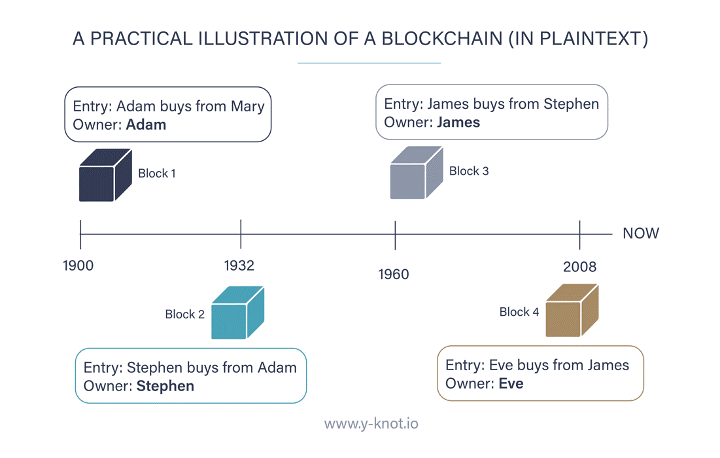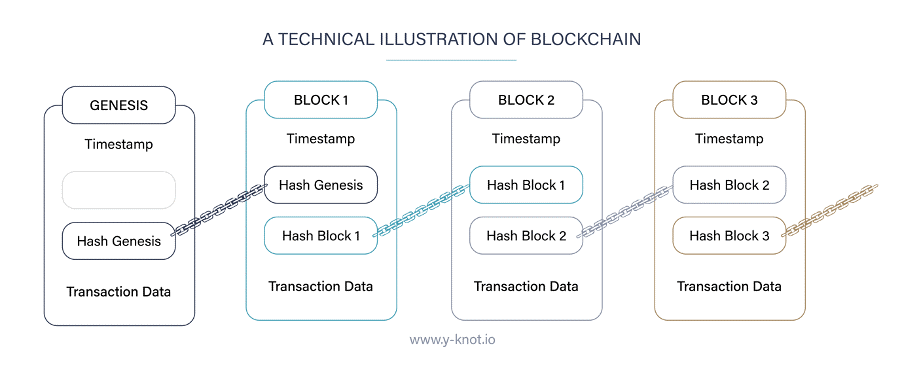Blockchain Technology
Blockchain as a type of DLT Part 1
Blockchain is part of a suite of DLTs that can be programmed to record and track anything of value. Blockchain is essentially a shared database filled with entries that must be confirmed (verified) and encrypted. Blockchain is built around cryptography, and cryptography enables the sharing of information in the presence of adversaries.
Let’s start with the basics: we all know what a chain is. A chain is a sequence of items of the same type forming a line, usually used to secure something. A chain starts at one point, and then links can be added ad infinitum which means that the chain can become longer and longer. Although a blockchain has no physical form, it helps to have the mental picture of a chain to learn about blockchain.
We started this series by introducing some of the key concepts that underpin blockchain technology: Decentralisation, cryptography and distributed ledger technology. (If you need to backtrack a bit, follow the links to read those sections before diving into this one).
If you have a clear understanding of distributed ledger technology (DLT) then we can venture deeper. Think of DLT and blockchain in the same way you might think of a boat and a sailboat. The former is a type of the latter. Blockchain is part of a suite of DLTs that can be programmed to record and track anything of value. Blockchain is essentially a shared database filled with entries that must be confirmed (verified) and encrypted. Blockchain is built around cryptography, and cryptography enables the sharing of information in the presence of adversaries.
Blockchain does not require a central authority to manage the operations, similar to DLT. In fact, it is completely decentralised. There are strict security protocols that require computational trust. This makes blockchain a trustworthy solution that allows for trustless transactions.
The blockchain organises the data in terms of blocks, hence the name. These blocks are linked to each other and encrypted for security.
Blockchain allows adding operations (append) only, i.e., you can add new data, but you cannot alter or delete existing data. That is one aspect that distinguishes it from traditional databases since you cannot alter or remove even a single block of data. Every transaction exists in history (timestamped). It is a non-destructive way to track data changes over time. This makes blockchain immutable.
Blockchain is one of the distributed ledger technology where every node gets its very own copy of the ledger, and it helps to ensure integrity and transparency of record-keeping [1].
We call each verified entry in the distributed ledger our block. Each block contains all the necessary information required to verify all the details of the transactions or events. Each block has a relationship with the previous block, and so on. When we connect these blocks by means of their relationship to each other, we have formed a "chain" of blocks, a.k.a blockchain.
Consider the following scenario as depicted in Figure 1. Say for example a dispute arise between Eve and Peter regarding the ownership of a piece of land that has been in the family for years. They made use of blockchain technology (which is a ledger method) where there is an entry recorded in the ledger which shows that Adam originally bought the property in 1900 from Mary.
When Adam sold the property to Stephen in 1932, a new entry was made in the ledger, and so on. Every change of ownership is represented by a new entry (block) in the ledger (blockchain), right up to Eve who bought it from James in 2008. Eve is the current owner, and is stored in the ledger. The dispute has been resolved.

Figure 1
Figure 1 is a simple practical illustration of a blockchain, and how it works in principle. Figure 2 shows the same blockchain, using technical terms.

Figure 2
If we continue with our example from Figure 1, the "first" block (original owner, Mary), is called the Genesis block. Genesis refers to the origin of the blockchain, with no previous connection to any other block. The date and time of the creation of the block are recorded, along with the details that Mary is the original owner. All the details inside the block are combined together, to create a hash value, called the genesis hash.
A hash is a type of "digital fingerprint" which identifies a block and its content. Changing information inside the block will automatically change the hash value. This makes it very easy to detect changes to blocks.
When Adam bought the land from Mary, a new block is created, Block 1. Block 1 contains all the data of this transaction, together with the hash value of the genesis block. Block 1 creates its own hash value from its content and saves the information. When Adam sells the land to Stephen, a new block is created which contains the content of the new transaction, together with the hash value of block 1, but it also creates its own hash value for block 2. The same process repeats itself when Stephen sells to James (block 3) and then when James sells to Eve (block 4 not shown).
Let’s just park it there for now. What we do know is that a blockchain is literally a chain (a sequence) of blocks filled with information and connected to one another. Just like a regular chain, new links (or blocks) can be added and the purpose of the chain is to secure valuable information. We will build on this understanding in part 2.
Blockchain as a type of DLT Part 2
If we have consensus as a sailing crew, then we all agree on the route we will take, so consensus is agreement and mutual approval. The blockchain establishes an agreement between all the participants in the network to determine who in the network is allowed to append a block to the chain.
If we continue with our example from part 1, the "first" block (original owner, Mary), is called the Genesis block. When Adam bought the land from Mary, a new block is created, Block 1. Block 1 contains all the data of this transaction, together with the hash value of the genesis block. When Adam sells the land to Stephen, a new block is created which contains the content of the new transaction, together with the hash value of block 1, but it also creates its own hash value for block 2. The same process repeats itself when Stephen sells to James (block 3) and then when James sells to Eve.
Okay, you’ve got it: blocks of information linked in a chain. What we still need to get to is why this particular system is so trustworthy and ‘tamper-proof’, as they say.
Consensus Protocol
The answer is simple - blockchain makes use of a consensus protocol. If we have consensus in a crew, then we all agree on the route we will take, so consensus is agreement and mutual approval. The blockchain establishes an agreement between all the participants in the network to determine who in the network is allowed to append a block to the chain.
Since blockchain is based on DLT, a copy of this blockchain-style ledger is distributed across multiple devices in the blockchain network, providing each device with its own copy.
When Peter heard that Eve was the true owner of the piece of land, he tried to maliciously change the ledger to show that he bought the land from James instead. This change to the ledger is recorded, but it caused the hash value of block 4 to change, which results in a new hash value. These changes in the hash will permeate through the entire blockchain network.
Since we distribute the ledger through the entire network, the changes cannot be verified by the nodes in the network, and the network will detect an illegal "edit" and will discard any changes. All the devices (called nodes) need to reach consensus before adding new blocks.
A consensus system [2] is an agreed set of network rules, and since every node abides by them, they become self-enforced inside the blockchain. This consensus system acts as a second layer of protection to the blockchain.
In the next instalment of our series we will explain the difference between public (permissionless) and private (permissioned) blockchains.
References
[1] Genov, E., 2021. The Longest Running Blockchain has Existed on NYT Pages Since 1995. [Blog] Toshi Times, Available: https://toshitimes.com/the-longest-running-blockchain-has-existed-on-nyt-pages-since-1995/ [Accessed 23 June 2021].
[2] Redka, M., 2021. The Future of Blockchain: Potential Use and Global Impact. [Online] Mlsdev.com. Available at: https://mlsdev.com/blog/the-future-of-the-blockchain-technology-use-cases-geographical-expansion-potential-risks-and-challenges [Accessed 22 June 2021].